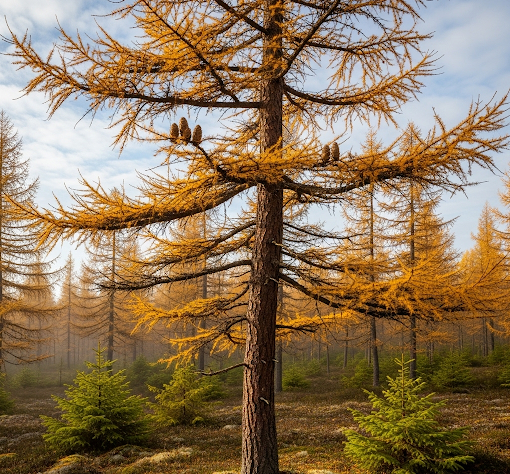Dahurian Larch Tree Seeds
Dahurian Larch Tree Seeds
Couldn't load pickup availability
Dahurian Larch Tree Seeds
(Larix gmelinii)
Larix gmelinii, commonly known as the Dahurian larch, is a deciduous conifer native to eastern Siberia, Mongolia, northeastern China, and parts of the Russian Far East. It is one of the most cold-hardy trees in the world, able to survive in areas with permafrost and temperatures that can drop below −50°C (−58°F). Unlike most conifers, it sheds its needles each autumn, giving it a distinctive seasonal appearance. In summer, its foliage is soft and bright green, while in autumn it turns a golden yellow before falling.
This tree typically grows 30 to 90 feet tall, with a narrow conical crown when young that becomes broader and more irregular with age. The bark is thin and flaky in younger trees, gradually becoming thicker and more deeply furrowed in older specimens. Its needles are borne in clusters on short shoots, while cones are small, oval, and light brown, maturing in one season. The seeds are small and adapted for wind dispersal, allowing the species to colonize harsh and open environments.
Larix gmelinii plays an important ecological role in boreal forest and taiga regions, providing habitat for wildlife and helping stabilize soils in cold, nutrient-poor areas. It is also valued for its timber, which is strong, durable, and resistant to decay, making it useful for construction, utility poles, and outdoor applications. In addition, its ability to grow in permafrost regions makes it a subject of interest for forestry and climate research, as it is one of the few trees capable of thriving in such extreme environments.
Zones: 3 to 6
Germination Range: 40-60%
Stratification Requirement: 30-45 days cold moist stratification.
Planting Instructions:
Before sowing, stratification is necessary to break dormancy. Place the seeds in a moist medium such as seed-starting mix or peat and keep them in refrigeration at about 1 to 5°C (34 to 41°F) for 30 to 45 days. This cold treatment mimics natural winter conditions and helps improve germination rates. Check periodically to ensure the medium stays damp but not soggy.
After stratification, prepare a well-draining seedbed or pots filled with a light, sandy soil mix. Sow the seeds about 0.5 to 1 centimeter deep, spacing them to allow room for growth. Lightly cover with soil and gently water to settle them in place. Maintain consistent moisture without waterlogging, as overly wet conditions can lead to rot. Dahurian Larch prefers full sunlight, so position your containers or beds where they will receive ample direct light.
Germination usually occurs within two to four weeks in warm conditions of around 15 to 20°C (59 to 68°F). Once the seedlings emerge, keep them in bright light and continue watering regularly. Protect young plants from strong winds, pests, and extreme temperature fluctuations. After one or two growing seasons, when the seedlings are sturdy enough, they can be transplanted to their permanent location in well-drained, sunny sites. Dahurian larch is adapted to cold climates, so it will thrive in areas with cold winters and cool summers.
Share


